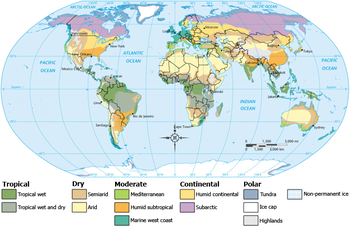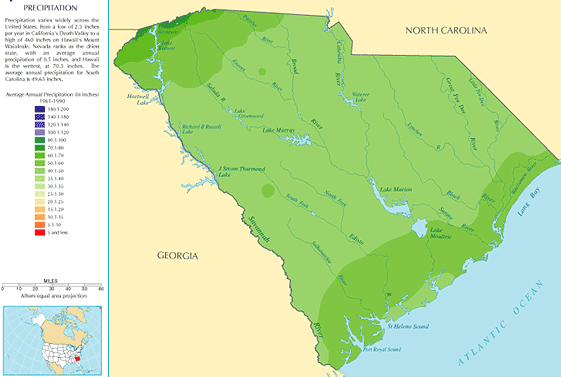
Climate of South Carolina
Encyclopedia

Humid subtropical climate
A humid subtropical climate is a climate zone characterized by hot, humid summers and mild to cool winters...
, with hot summers and winters that are not extremely cold. On average, between 40 inches (1,016 mm) and 80 inches (2,032 mm) of precipitation falls annually across the state. Tropical cyclone
Tropical cyclone
A tropical cyclone is a storm system characterized by a large low-pressure center and numerous thunderstorms that produce strong winds and heavy rain. Tropical cyclones strengthen when water evaporated from the ocean is released as the saturated air rises, resulting in condensation of water vapor...
s and afternoon thunderstorms due to hot and humid conditions contribute to precipitation during the summer and sometimes fall months, while extratropical cyclone
Extratropical cyclone
Extratropical cyclones, sometimes called mid-latitude cyclones or wave cyclones, are a group of cyclones defined as synoptic scale low pressure weather systems that occur in the middle latitudes of the Earth having neither tropical nor polar characteristics, and are connected with fronts and...
s contribute to precipitation during the fall, winter, and spring months. Tornadoes are most common in the spring with a secondary peak in November. Hail and damaging winds often occur in summertime thunderstorms. Tornadoes are very uncommon in the summer unless a tropical cyclone is present.
Temperatures
South Carolina has a humid subtropical climateHumid subtropical climate
A humid subtropical climate is a climate zone characterized by hot, humid summers and mild to cool winters...
(Koppen climate classification
Köppen climate classification
The Köppen climate classification is one of the most widely used climate classification systems. It was first published by Crimea German climatologist Wladimir Köppen in 1884, with several later modifications by Köppen himself, notably in 1918 and 1936...
Cfa), although high elevation areas in the "Upstate" area have less subtropical characteristics than areas on the Atlantic coastline. In the summer, South Carolina is hot and humid with daytime temperatures averaging near 90 °F (32.2 °C) across most of the state with overnight lows near 70 °F (21.1 °C). Winter temperatures are much less uniform. Coastal areas of the state have very mild winters with high temperatures averaging near 60 °F (15.6 °C) and overnight lows near 38 °F (3.3 °C). Further inland in the Piedmont
Piedmont (United States)
The Piedmont is a plateau region located in the eastern United States between the Atlantic Coastal Plain and the main Appalachian Mountains, stretching from New Jersey in the north to central Alabama in the south. The Piedmont province is a physiographic province of the larger Appalachian division...
, temperatures average between 50 °F (10 °C) during the day and 32 °F (0 °C) at night.
| Monthly Normal High and Low Temperatures For Various South Carolina Cities | ||||||||||||
| City | Jan | Feb | Mar | Apr | May | Jun | Jul | Aug | Sep | Oct | Nov | Dec |
|---|---|---|---|---|---|---|---|---|---|---|---|---|
| Charleston | 59/37 | 62/39 | 69/46 | 76/52 | 83/61 | 88/68 | 91/72 | 89/72 | 85/67 | 77/55 | 70/46 | 62/39 |
| Columbia | 55/34 | 60/36 | 67/44 | 76/51 | 83/60 | 89/68 | 92/72 | 90/71 | 85/65 | 76/52 | 67/43 | 58/36 |
| Greenville | 50/31 | 55/34 | 63/40 | 71/47 | 78/56 | 85/64 | 89/69 | 87/68 | 81/62 | 71/50 | 61/41 | 53/34 |
Precipitation

Appalachian Mountains
The Appalachian Mountains #Whether the stressed vowel is or ,#Whether the "ch" is pronounced as a fricative or an affricate , and#Whether the final vowel is the monophthong or the diphthong .), often called the Appalachians, are a system of mountains in eastern North America. The Appalachians...
lowers annual precipitation across central portions of the state. Inland sections average 40 inches (1,016 mm) to 50 inches (1,270 mm) of rainfall, while near the coast 50 inches (1,270 mm) to 60 inches (1,524 mm), and the Piedmont receives 70 inches (1,778 mm) to 80 inches (2,032 mm) of precipitation.
Snowfall and ice
Snowfall in South Carolina is not very excessive with coastal areas receiving less than 1 inches (2.5 cm) on average. It is not uncommon for areas along the coast (especially the southern coast) to receive no measurable snowfall in a given year. The interior however receives more snow. The snowiest location in the state averages as much as 12 inches (30.5 cm) of snow a year in the Blue Ridge MountainsBlue Ridge Mountains
The Blue Ridge Mountains are a physiographic province of the larger Appalachian Mountains range. This province consists of northern and southern physiographic regions, which divide near the Roanoke River gap. The mountain range is located in the eastern United States, starting at its southern-most...
of the state. Freezing rain
Freezing rain
Freezing rain is the name given to rain that falls when surface temperatures are below freezing. The raindrops become supercooled while passing through a sub-freezing layer of air, many hundred feet , just above the surface, and then freeze upon impact with any object they encounter. The resulting...
is more common than snow and even rain across much of the state in the winter months.
Tropical cyclones

Hurricane Hazel
Hurricane Hazel was the deadliest and costliest hurricane of the 1954 Atlantic hurricane season. The storm killed as many as 1,000 people in Haiti before striking the United States near the border between North and South Carolina, as a Category 4 hurricane...
(1954) and Hurricane Hugo
Hurricane Hugo
Hurricane Hugo was a classical, destructive and rare Cape Verde-type hurricane which struck the Caribbean islands of Guadeloupe, Montserrat, St. Croix, Puerto Rico and the USA mainland in South Carolina as a Category 4 hurricane during September of the 1989 Atlantic hurricane season...
(1989), which were of category 4 strength. For weaker systems, rainfall and spin-up tornadoes in the outer bands are the main impacts to the state. The wettest known tropical cyclone to impact South Carolina was a tropical depression named Jerry
Tropical Storm Jerry (1995)
Tropical Storm Jerry was a tropical storm that caused severe flooding throughout the southeast United States in August of the 1995 Atlantic hurricane season...
in 1995 which stalled nearby and had previously been a tropical storm across Florida. Jerry brought nearly 19 inches (482.6 mm) of rainfall to upstate South Carolina.
Thunderstorms and tornadoes
South Carolina averages around 64 days of thunderstormThunderstorm
A thunderstorm, also known as an electrical storm, a lightning storm, thundershower or simply a storm is a form of weather characterized by the presence of lightning and its acoustic effect on the Earth's atmosphere known as thunder. The meteorologically assigned cloud type associated with the...
activity per year. Most thunderstorms occur during the summer. South Carolina is vulnerable to tornadoes. Some notable tornadoes have struck South Carolina and the state averages around 50 tornadoes annually. There have been no F-5 tornadoes on record but over a dozen F-4 tornadoes have occurred in many counties in South Carolina.
See also
- Climate of the United StatesClimate of the United StatesThe United States includes a wide variety of climate types due to its large size, range of geographic features, and non-contiguous arrangement. In the contiguous United States to the east of the 100th meridian, the climate ranges from humid continental in the north to humid subtropical in the...
- List of wettest tropical cyclones in South Carolina
- United States rainfall climatologyUnited States rainfall climatologyThe characteristics of United States rainfall climatology differ significantly across the United States and its possessions. Late summer and fall extratropical cyclones bring a majority of the precipitation which falls across western, southern, and southeast Alaska annually...
- List of South Carolina weather records

